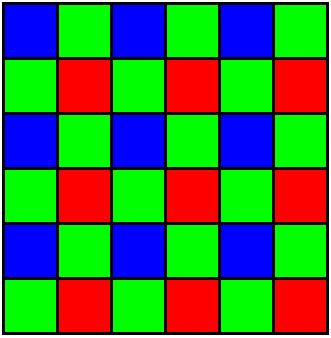A process of “developing” pictures from RAW image sensor.
Demosaicing is also known as Debayering. It is a process in which viewable images are created using RAW data from a camera CMOS sensor. Photosites or light sensitive units (pixels) in a color filter array are typically arranged in Bayer pattern [Fig.1].
Because each photosite can be sensitive to only one of primary colors, the red, green and blue elements are interspersed in an alternating pattern which contains 50% green, 25% red and 25% blue pixels.
RAW images do not look correct to the eye and need to be processed before use. This process is known as demosaicing. During demosaicing full RGB values for each pixel are determined using various interpolation algorithms. There is a trade off between the speed and the quality of debayering. Photosites are sensitive to linear light. The linear values are gamma corrected to achive a tonal distribution acceptable to human eye during debayering or as a separate last step, and sometimes both.
This process takes place inside consumer cameras and is transparent to the photographer. Higher end still cameras and digital film cameras like RED ONE allow some level of user control over the demosaicing settings.

Fig. 1
